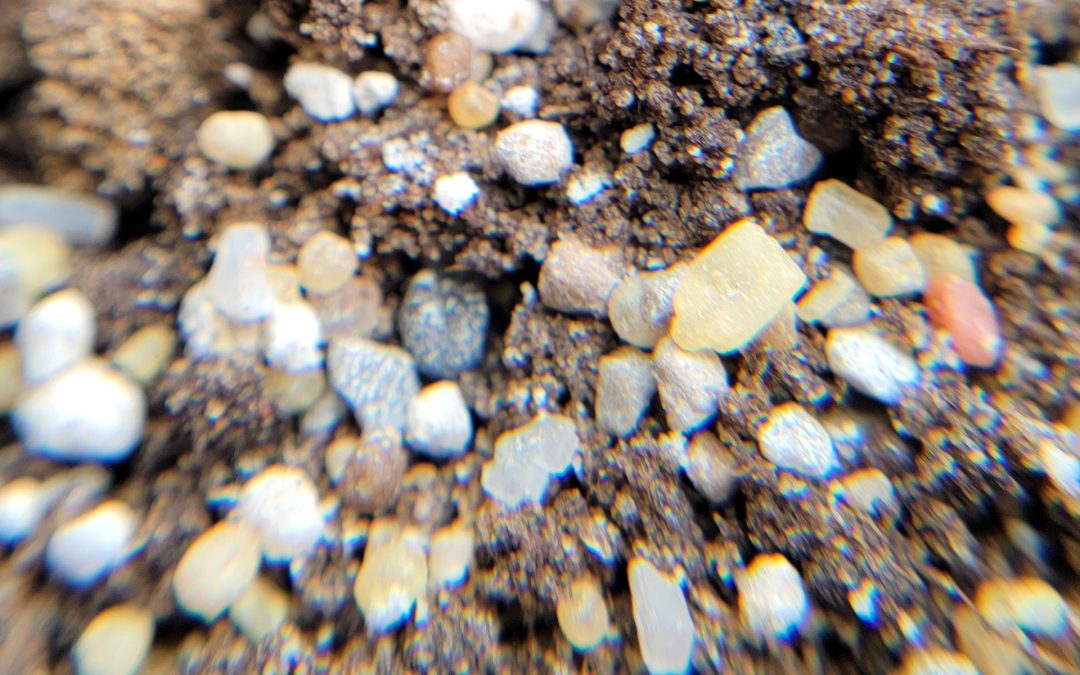
by Joshua Criss | Mar 6, 2025
Ah, springtime is approaching quickly. You and I both know you’re getting anxious to get out into your gardens to grow your plants. I’m not faulting you, far from it. You’ll find that your local Extension agents want your garden to succeed as much as you do. Because we all want you to have a bountiful harvest, we need to have a conversation about fertility in your lawns and gardens.
Definitions
Before we get too deep into this topic, let’s define nutrition. You may hear some refer to fertilizers as “plant food.” While this is a common phrase concerning fertilizers, it is not factually accurate. Food is associated with energy creation within an organism. Plants are autotrophs, meaning they convert sunlight into energy. So, under this premise, sunlight is plant food, whereas plant nutrition is the building blocks of tissues or catalysts of metabolic processes.
The 17 elements designated as plant essential nutrients are categorized based on the quantity needed for healthy growth. All are important to have in your soil; as per the “Law of the Minimum,” your plant’s development will be limited based on the most deficient element.

UF/IFAS Photo
Macros
Those elements with the largest demand within the plant are known as macronutrients. The three most critical of these are very often absent in fertilizer conversations as they cannot be added to soil in granule form. These are carbon, hydrogen, and oxygen, and their presence in your garden results from your cultural practices. You get them from air and water in the pore spaces of your soil. Appropriate tillage and irrigation are the only ways to provide these elements to your plants. They are critical for proper photosynthesis and fluid balance in the plant.
The most discussed elements are so vital that they make up the three numbers on every bag of fertilizer. These are nitrogen (N), phosphorous (P), and potassium (K), all of which may be added to soil to overcome deficiencies (N often being the limiting factor). These elements are crucial for protein creation, photosynthesis, and fluid movement.
Secondary Nutrition

UF/IFAS Photo: J. Criss
The next set of nutrients have less demand than NPK. They are sulfur (S), magnesium (Mg), and calcium (Ca). Ca is essential for cell structure but is often abundant in our soils. S is frequently rained out of the atmosphere (though you may still need to add some) and facilitates enzymatic processes in plant cells. Mg needs the most attention in this category as it has a lot of mythology among gardeners. You’ve likely heard you should add this element to “green up” your plants. While it is true that Mg is critical to chlorophyll, adding it without testing for deficiencies first is a recipe for poor plant growth.
Micros
Our final category of fertilizer is micronutrients. These are iron (Fe), manganese (Mn), boron (B), chlorine (Cl), zinc (Z), copper (Cu), molybdenum (Mo), and nickel (Ni). These serve various functions in the plant, mainly in metabolic processes.
To Sum Up
Plant fertilization is critical for lawns and gardens. It behooves gardeners to understand these elements and their role in plant growth. Once you do, you’ll understand the importance of applying the correct version of the element in the proper amount at a time and location to maximize use efficiency. You can learn more about what they do and how they react in the soil here. For more information, contact your local extension office.
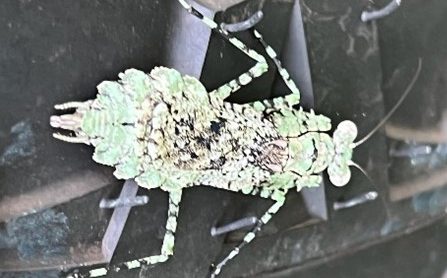
by Donna Arnold | Feb 27, 2025
Extension agents occasionally receive calls about “alien” bug sightings, sparking concern among residents. One such insect, Gonatista grisea, commonly known as the Grizzled Mantis, Florida bark Mantis or Lichen Mimic mantis, often raises alarm. But there’s no need to panic—this mantis is a fascinating and harmless part of our ecosystem.

Photo Credit: Vincent Moore, Sweet Magnolia Ridge.
The Grizzled Mantis is native to the United States, ranging from southern Florida to Georgia and South Carolina, and is also found in Puerto Rico, Jamaica, and Cuba. Adults are relatively small, with males measuring 36–38 mm and females slightly larger at 37–40 mm. Their grayish-green coloration and mottled dark markings provide excellent camouflage, allowing them to blend seamlessly into their surroundings, such as lichen-covered bark. They are characterized by triangular heads and large eyes, perfect for their ambush hunting style.
Quick and agile, Grizzled Mantids scuttle rapidly away from perceived threats. They exclusively prey on arthropods, adopting a head-down ambush position while resting on tree bark. Their preferred plants include sea grape, gumbo limbo, water oak, and magnolia, though they are not limited to these species.
Interestingly, mantids are gaining popularity as low-maintenance pets. Some enthusiasts collect egg cases or purchase late-stage nymphs. However, keep in mind that newly hatched mantids require ample food or separation, as they can become cannibalistic if resources are scarce.
Whether in the wild or as pets, the Grizzled Mantis is a unique and beneficial insect, playing a role in controlling arthropod populations. So, the next time you spot one, there’s no need for fear—just appreciation for this remarkable creature!
For more information, contact your local Extension Office or click on the link Grizzled mantid – Gonatista grisea.

by Mark Tancig | Feb 27, 2025
It’s almost March and it’s not just March Madness that’s about to happen, but No Mow March. This year will be the third year that the Horticulture Extension Agents of the UF/IFAS Northwest District have promoted No Mow March. The No Mow March campaign encourages those with lawns to leave some late winter/early spring wildflowers to benefit wildlife.
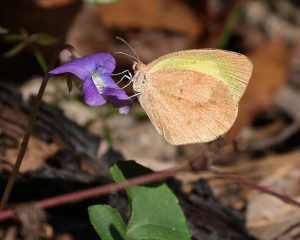
A Barred Yellow butterfly visit a violet, one of our late winter wildflowers that can be found in your lawn. Credit: Steve Coleman.
If you don’t think you’re ready to skip mowing the whole lawn for the whole month of March, then maybe you could try a small piece and hold off as long as you can. The point is to get you thinking of how your lawn, usually not considered an inviting place for most wildlife, can actually provide valuable ecosystem services. Many pollinator species in our area are emerging from their winter break and looking for food as we move into March. Plants in your lawn that are typically considered “weeds” are perfect pollinator feeders at a time when other landscape plants have yet to begin flowering. Providing extra floral resources can be especially useful in more developed areas where well-kept landscapes reduce what’s available for pollinators. Since the health and abundance of insect pollinators contribute to the ability of higher organisms, especially birds, if there’s more insects, then there’s more food for the birds, too!

While you’re not mowing, try observing the wild plants and animals that visit your lawn. You can get help identifying them by using apps like iNaturalist or Seek. You could also spend some time ripping out part of the lawn and planting a new flower bed of native plants. Or you can focus on identifying any invasive plant species in your landscape and work on removing them.

Instead of mowing, take a walk in the wildflowers during March. Credit: Taking a Walk near Argenteuil by Claude Monet.
The Horticulture Extension Agents of the UF/IFAS Extension Northwest District have put together a No Mow March website with more information, including a list of related workshops and classes, as well as a pledge you can take to affirm your choice to participate.

by Sheila Dunning | Feb 19, 2025
As the temperatures warm into the 60’s (or greater) and the rain chance remains good, keep an eye open for disease in your lawn. Large patch disease is common in turfgrass this time of the year. It is caused by the fungus Rhizoctonia solani. The fungus is present in the soil and thatch layer year-round. When the temperatures rise into the 60’s and 70’s it begins to spread. Large patch thrives under these conditions, especially when the soil is wet. With frequent showers the disease spreads quickly. The first symptom of large patch is circular, discolored areas within the lawn. The outer borders of the patches are orange to yellowish in color. In the center of the circle there are grass blades trying to green up again. They are usually unsuccessful, resulting in odd-shaped patches of dying grass that begin to connect to each other.
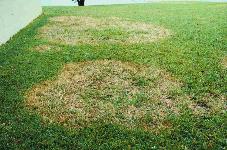
Picture from UF publication
A simple field diagnostic techniques to confirm large patch disease is to pull on the diseased grass shoots near the edge of the circle. The blades will come loose from the stolon easily. At the base of the leaves the stem and sheaths will appear dark brown and rotten. Yes, it is large patch.

Photo from UF publication
If the weather gets colder or hotter very quickly, the disease will go back into dormancy. Looking at the long-range temperature predictions, the rest of February will be going up and down. Remember, the groundhog said six more weeks of winter. So, start looking for a fungicide or two or contact your pest control service. However, remember fungicides don’t cure existing problems. They are utilized as a protectant for the unaffected portions of the grass. When favorable conditions are present, the turf should be sprayed in order to keep the fungus from penetrating the grass blades. Repeat applications will be needed for as long as the weather is cool and wet. Check the product label for the correct intervals. Several cultural practices promote large patch infection including over-fertilization, over-irrigation, low mowing height, poor drainage and excess thatch. This spring, after the grass has greened-up on its own, is a good time to look at these factors and make corrections. Keep a close eye because as soon as the temperatures drop again in the fall, large patch can reappear if the corrections were not complete. For more information: https://edis.ifas.ufl.edu/lh044
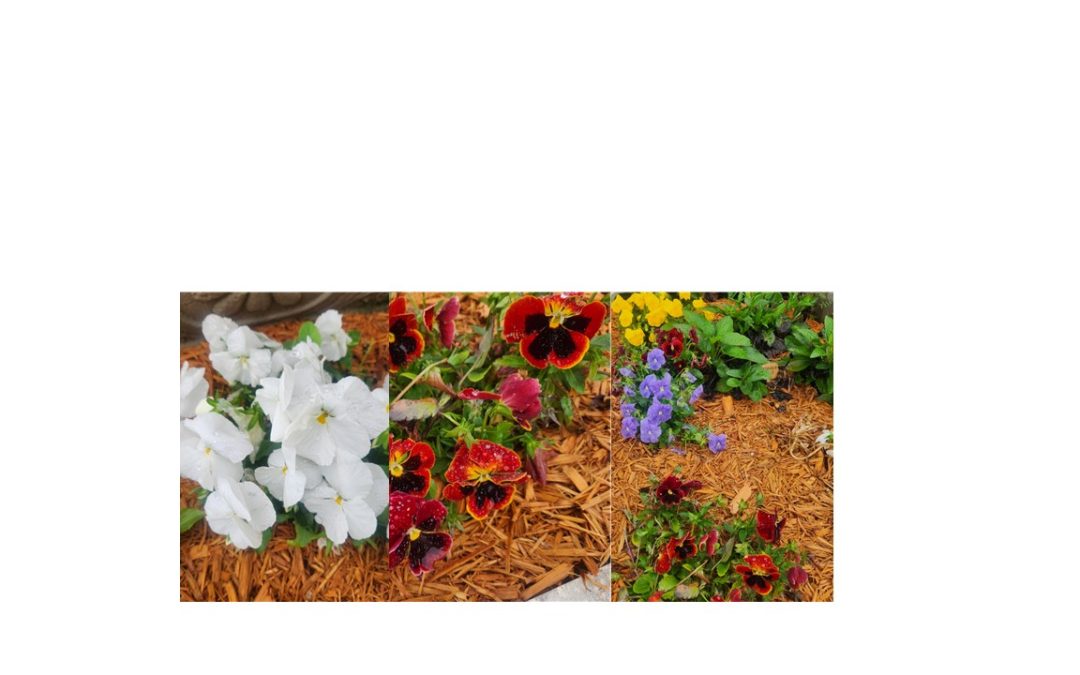
by Donna Arnold | Feb 19, 2025
 Growing pansies in North Florida is a rewarding experience, as these resilient flowers thrive in cooler temperatures. As I walked up to our front office after the ice had melted away, I was amazed to see their vibrant blooms still standing strong, displaying their cheerful faces despite the harsh conditions of the January 2025 winter storm. Their endurance is a testament to their hardiness, making them a perfect choice for winter gardens. Here’s a guide to help you successfully cultivate pansies in our region.
Growing pansies in North Florida is a rewarding experience, as these resilient flowers thrive in cooler temperatures. As I walked up to our front office after the ice had melted away, I was amazed to see their vibrant blooms still standing strong, displaying their cheerful faces despite the harsh conditions of the January 2025 winter storm. Their endurance is a testament to their hardiness, making them a perfect choice for winter gardens. Here’s a guide to help you successfully cultivate pansies in our region.
Best Planting Time
Pansies thrive in cooler weather, making fall (October–November) the ideal time to plant them. Once established, they will provide stunning blooms throughout the winter and into early spring. While they can tolerate mild frosts, Florida’s summer heat is too intense for them, so they are best treated as a seasonal flower.
Choosing the Right Variety
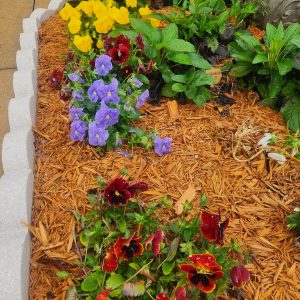 Not all pansies are well-suited for Florida’s fluctuating temperatures. To ensure a successful and long-lasting display, select heat-tolerant varieties such as Majestic Giants, Matrix, or Delta Series, which are known for their resilience and vibrant blooms.
Not all pansies are well-suited for Florida’s fluctuating temperatures. To ensure a successful and long-lasting display, select heat-tolerant varieties such as Majestic Giants, Matrix, or Delta Series, which are known for their resilience and vibrant blooms.
Delta Series – A popular choice for its bold yellow, purple, and blue flowers. This variety is highly valued for its disease resistance, vigorous growth, and ability to withstand both cold and mild heat.
Majestic Giants – A classic pansy cultivar known for its large, eye-catching blooms in a variety of colors and patterns. These compact plants thrive in both container gardens and mass plantings.
Matrix Series – This variety produces dense, bushy plants with large flowers, making it an excellent choice for creating colorful, impactful displays in both garden beds and containers.
By choosing the right variety, you can ensure your pansies thrive throughout the cooler months, bringing beauty and color to your landscape.
Sun and Soil Requirements
For the healthiest plants, provide full sun to partial shade, with at least 4–6 hours of direct sunlight each day. Pansies prefer well-draining soil rich in organic matter, with a slightly acidic to neutral pH (5.5–6.5). Improve your soil’s structure by adding compost or peat moss, which enhances both drainage and nutrient content.
Watering & Care
Maintaining proper moisture levels is key to keeping pansies healthy. Water them 2–3 times a week, ensuring the soil remains moist but not soggy. A layer of mulch will help retain moisture and reduce weed growth. To encourage continuous blooms, apply a balanced, slow-release fertilizer every few weeks and remove spent flowers (deadheading) to keep plants looking fresh and vibrant.
Common Challenges & Solutions
Despite their hardiness, pansies can face a few challenges:
Heat Sensitivity: If temperatures rise unexpectedly, pansies may wilt. Providing afternoon shade can help them cope.
Pests: Keep an eye out for aphids, slugs, and caterpillars. Use insecticidal soap or remove pests by hand to prevent damage.
Fungal Diseases: Avoid overhead watering to prevent root rot and mildew. Ensuring good air circulation will also help reduce disease risks.
Spring Transition
As spring temperatures climb, pansies will naturally begin to decline. To maintain a colorful garden, consider replacing them with heat-tolerant flowers such as zinnias, marigolds, or vincas, which can handle Florida’s warm and humid conditions.
Their cheerful, expressive blooms make them a wonderful choice for adding color and charm to your landscape. Happy planting!
For more information contact your local extension office.















